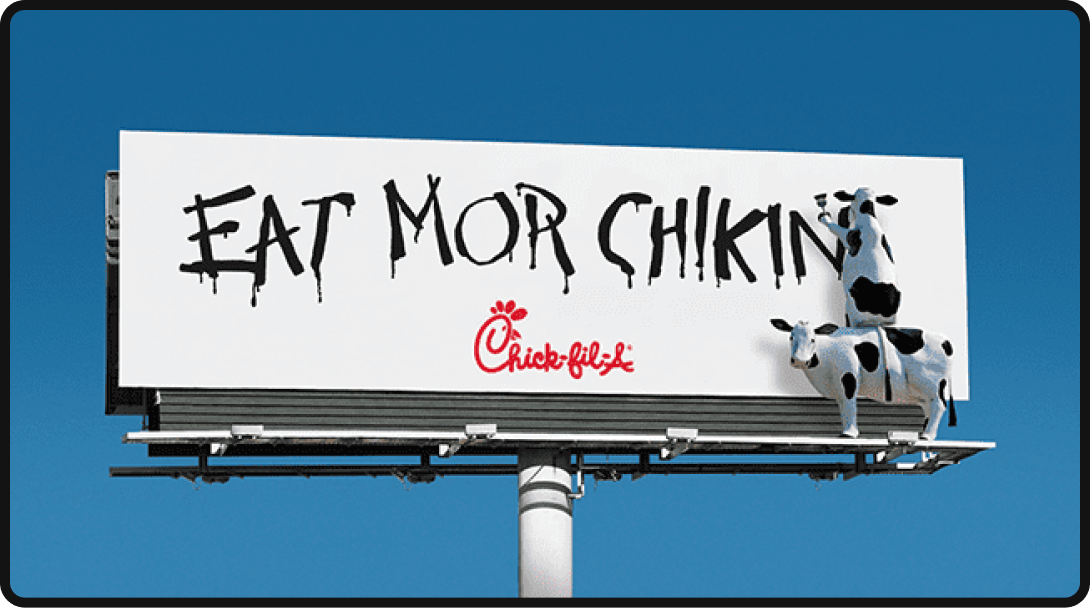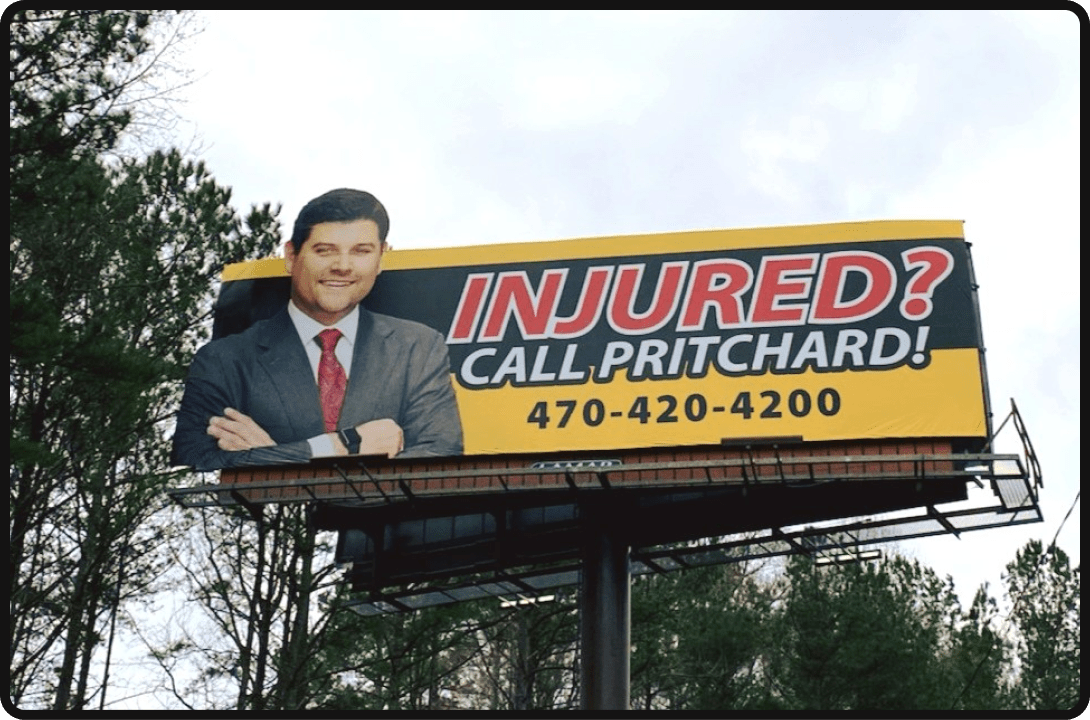
Picture this: towering billboards, vibrant transit ads, street furniture, and wallscapes that command attention amidst the urban landscape. Out-of-home marketing is the oldest and most resilient form of communicating with commercial interests. Dating as far back as 3000 BC in Thebes, Egypt, the use of papyrus business posters was discovered with ad copy still intact. One fabric factory boasted they’re “…where the best cloth is woven to your desires.”
Or in China’s Song dynasty, around 1,000 AD, a needle poster read “We buy high-quality steel rods and make fine quality needles that are ready for use at home in no time.” Isn’t it kind of eerie how, even when translated, this copy holds up to today’s standards?
Vendors in Italy, Rome, and Greece would carve or paint ads onto boulders and buildings in areas with high foot traffic. Here’s one of a gladiator giving a thumbs up in the direction of a path that leads to an amphitheater used for combat.

So… How do you master OOH marketing? Where do you start? Let’s start with the needed context.
- What is OOH marketing?
- What are examples of OOH marketing?
- What is an example of OOH branding?
- What’s an example of digital OOH?
- What are some best practices for OOH marketing in 2024?
- How do you measure OOH marketing?
What is OOH Marketing?
OOH, or Out-of-Home marketing, is the art of capturing consumer attention when they’re on the move. Think of it as branded graffiti decorating the city walls of consumer consciousness, always there, always making a statement. If you’re out and about, and you see an advertisement that isn’t on a personal device, that’s most likely out-of-home advertising.
The streets reward vigor. A one-person team with cardboard signs, a staple gun, and telephone poles mapped out in their head is no less a pristine example of OOH advertising than a team of 10 with a $1M budget.
In terms of revenues, the Out of Home Advertising Association of America (OAAA) estimated that US streets, subways, and more generated $1.96B in 2023 — just over a 1% increase year over year. There are around 2,100 out-of-home marketing operators in the US, with an average of $9.3M in annual revenues.
Much of that advertising is being done in the form of billboards, of which there are more than 350,000 in the USA. Billboards aren’t the only form of out-of-home marketing, though.
What Are Examples of OOH Marketing?
Out-of-home advertising examples are extremely diverse and can include:
- Billboards
- Novelty Inflatables
- Sign Spinners
- Plane / Aerial banners
- Murals / Wallscapes
- Transit advertising
- Street Furniture
- Street Posters
- Digital Kiosks
- Experiential popups
- Stadiums / Arenas
- A Barber’s Pole
- Ice Cream Truck Music
- Blimps
- Bumper Stickers
- Airports
- Newsstands
- Standalone Banners
- Store, Restaurant, Gas Station, Theater and Mall Marquees
- Sides / back of trucks, busses
- Retail Windows
- A “Barker” or official street solicitor for a nearby business
- Use of Scents
- Aircraft
- Spray Chalk and Stencils
- Yard Signs
- Novelty Vehicles
What Is an Example of OOH Branding?
Take a moment. Think of a billboard campaign you remember from a long time ago.
For many readers, one of those billboard campaigns is from Chick-Fil-A.
Chances are, Chick-Fil-A’s billboard ads were seen as a huge risk by some of the team members that created that lasting memory for some of us. Back in 1995, getting the cows up there and anchoring them might very well have cost more than the billboard itself, but we know it was the right decision because those cows have lived well into 2024 encouraging us to do things like “eat mor chicken.”

Even at a great distance, all you really need is to see a bovinated rectangle to know Chick-Fil-A isn’t too far. The consistency and duration of Chick-Fil-A’s billboard campaign is their biggest testament to success at OOH branding. That they’ve achieved brand awareness and sales with cow-themed visuals is also something not to be ignored.
What’s an Example of Digital OOH?
Times Square is one of the most iconic landscapes known for its digital out-of-home advertisements. Their cost? About double – compared to their static counterparts. Digital billboards in Times Square cost between $10,000 – $22,000 per month vs. regular billboards, which hover around $3,000 – $15,000. Digital OOH advertisements are more expensive in general because of a good handful of benefits.
Digital OOH benefits:
- Digital out-of-home ads are easier to buy because ad sales can be automated. This method of buying digital OOH ads is referred to as Programmatic DOOH and saves advertisers lots of time because of how efficient it is compared to manual buying.
- DOOH ads have digital screens with vibrant backlighting that’s more prominent than traditional lamps on printed canvas.
- Animations and dynamic content capture more attention than static images.
- Privacy concerns that plague traditional digital marketing channels vanish because no personal devices are required.
- Real-time data can be plugged directly into the creative, like when Benadryl shared local pollen counts to drive antihistamine sales in the UK.

What Are Some Best Practices for OOH Marketing in 2024?
1. Speak With Brevity
You don’t have a lot of time to communicate with your target audience. When someone’s looking at an OOH advertisement, they’re very often moving. Don’t give them something that requires them to slow down.
2. Leverage Past Learnings
Typically, organizations that have a budget for billboards also have digital ad budgets. Ad platforms like Meta offer a wonderful testing ground for different creatives and messaging. Users on Meta and other social platforms will go so far as to actually tell you what they think of your ads, even if you don’t ask them.
By testing different creatives and messaging before rolling out an OOH campaign, you can use assets already known to have a proven built-in audience. You don’t want to roll the dice when you put OOH ad units up, and it’s great when you can prove you aren’t rolling the dice with something tangible, like metrics from previous ads.
3. Be Persuasive and Bold
You need your most effective comms here. Turn the volume up as loud as you possibly can without jeopardizing branding or trust. This isn’t the place to say, “Sign up today.” Many people have seen this phrase more than 5,000 times in their lifetime. Hit them with verbiage that forces them to read the end of the phrase or sentence.
4. Factor Audience Distance in Your Creative
The distance you are from your screen right now is much closer than the average distance between your future OOH audience and your copy. I know what you might be thinking; “But billboards are 48 feet wide … so it’s okay if they’re far. It should all still translate, right?” No, fellow marketer! Make your OOH text a little bigger than your typical (digital) creative assets.
5. Physically Visit Your OOH Ad Locations and Research Them Before Purchasing the Ad Unit
Playing on the environment and adding something innovative to the ad that ties into the surrounding area isn’t the only benefit. There are also (rarely) viewability issues with locations that you just can’t know until you get there.
Some examples of viewability blockers include:
- Rain: It’s best not to purchase OOH advertising units that rely on foot traffic during the rainiest month in any particular city.
- Foliage: Your OOH ad unit could be partially blocked by foliage that you can’t see in pictures that are used to sell the ad.
- Graffiti: Enough spray paint can invalidate an ad unit. If you’re purchasing wall posters in LA (not to name anyone in particular), walk down the street and do a quick spray paint check on what’s already live.
- Broken Pixels: It happens. Giant vertical or horizontal lines and squares of off-color (or even totally dark) pixels can splotch your DOOH ads. Sometimes, it’s only one or two pixels, but you can also have 15% of the board out of service while clients unknowingly continue to pay full price.
6. Being Clever Can Work
Cleverness is a common theme among those who populate first for “best outdoor ads of all time.” Providing something clever speaks to the soul and can be a true breath of fresh air for someone rightfully numbed by your typical “ACCIDENT? CALL NOW!” injury attorney billboard. It should be no surprise these billboards are strategically placed in high-traffic areas where accidents can occur.
What is surprising, though, is the frequency at which injury attorneys are featured smiling. Now, I get it. You gotta smile. I wouldn’t advise an injury attorney not to smile for their billboard. I mean, just look at Mr. Pritchard here. His smile is damned fantastic.

At the same time, 42,939 US drivers die annually behind the wheel. So, why do we expect injury attorneys to smile in their out-of-home marketing? It could be because, at this moment, our happy congregation and opportunity with the Pritchard injury firm supersedes anything that has happened in the past.
It’s this juxtaposition of smiling and the subject matter of escaping death that can feel so novel when you look at it through the lens of whether or not real-life examples of dystopia could exist in OOH marketing, but I digress. Let’s talk about measurement.
How Do You Measure OOH Marketing?
If you’ve been spoiled by the dashboards of digital platforms that tell you every iota of information you could ask for, prepare to take a small hit to attribution. The reporting aspect of OOH marketing is not as great as that of its digital counterparts.
- Unique Identifiers: QR Codes, Email Addresses, Hashtags, Phone numbers, Promo codes, and URLs specific to your out-of-home campaign can be tied directly back to your efforts. These are your best bets for attribution.
- Foot/Car Traffic: Estimates of foot traffic specific to your target area can be used to derive how many people could have seen your ads.
- Web Traffic / Social Mentions: A spike in website traffic that corresponds to the time and geo-location of the OOH campaign can be an acceptable indicator of impact.
- Surveys: A geo-specific before and after survey to measure lift in awareness is one way to test the effectiveness of an OOH campaign. Surveys can be done via Google, various third parties, targeted social media polls, or in person at places like malls.
There’s a near-infinite number of approaches one could take to the streets for their out-of-home ads. Nature rewards successful outcomes for those marketing efforts no differently than it does a primal animal marking its territory to claim the resources that come with it.






